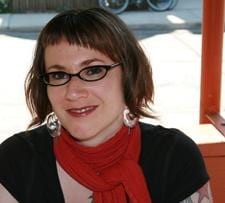I recently met Debra Anderson at the Boulevard Café in Toronto. She just won the 3rd annual Dayne Ogilvie Award. The $4,000 prize is administered by the Writers’ Trust of Canada and is given to an emerging queer Canadian writer each year.
Debra Anderson is a Toronto-based writer, playwright and filmmaker. Her first novel, Code White, is narrated by twenty-four-year-old Alex, who wakes up in a psychiatric ward and tells the story of her confinement.
Capital Xtra: First of all, congratulations on winning the 2009 Dayne Ogilvie Award. How do you feel?
Debra Anderson: Extremely honoured. It’s thrilling for me to receive this kind of accolade.
CX: How long did it take you write Code White?
DA: About five years. At the beginning, I wrote when the urge struck. There were long periods when I’d pause. Eventually those pauses became infrequent, and then I just charged forward.
CX: Code White is a very sexy book with sexy characters.
DA: Um, thanks! People who have read the book have been surprised at how sexy and funny it is. I wanted to show that life doesn’t stop if you get sick. A character will still have their sense of humour and their desire. All too often, people who are sick are infantalized. My priority was to create a fully dimensional main character that readers would be able to relate to.
CX: There’s a profound existential undercurrent in the book. Alex says, “There is beauty everywhere.” Her experience of life is so intense. Can you speak to that?
DA: Everyday life can be so mundane. That dredge pushes most of us down with responsibilities, errands and to-do lists. Often, it’s difficult to see past the pile of laundry waiting to be done in the corner. But what Alex experienced when she was manic was to surpass the grey everyday and to experience the glory and glitter in that very same everyday. In Code White, I wanted to invite people to see a glimmer of the same.
CX: What do you love about writing?
DA: The reason I love to write is the same reason I love to read. It’s a way of understanding what we’re all doing here. When I read fiction about other people’s lives, I get a clearer sense of what I’m doing here and who I am. All these tiny moments of connection. Reading and writing are such an amazing way to be intimate with people.
CX: What inspired you about the narrator, Alex?
DA: I have a soft spot for Alex, because she’s so sassy. She’s in this psychiatric institution, and in a situation where everyone thinks she’s crazy. Everything is beige, and they try to make her beige. Her reaction is: “Fuck you, I’m hot pink.”
CX: What was the challenge in writing this book?
DA: I annoy everyone in my life with my incessant need to plan, so it was a terrifying experience to write a novel not knowing the ending. Following the flow of the story was exciting, but definitely a challenge.
CX: Why did you choose to take on mental illness, a subject that’s still very much taboo?
DA: I was interested in writing a story about mental health, because there’s such a stigma around it and I wanted to challenge people’s stereotypes. I created a character who entered a psychiatric institution for the first time, so that my readers could experience that world too.
CX: What stories are exciting to you?
DA: I like to read about people and situations that aren’t part of the dominant hegemony—misfits or outcasts who fall outside of mainstream culture. That’s what gets my heart to stop, and that’s what I hope to capture as a writer.
CX: How did the process of writing the book change you?
DA: A lot of times, we want to do something, but the noise and demands in our day-to-day life are so loud. I feel lucky that I was able to give this novel voice and shape, and push through that voice everyone has that says, “I can’t.”

 Why you can trust Xtra
Why you can trust Xtra


